
Introduction
It's been about 18 months since we saw some
interesting new models from HP. They have of course been producing monitors and
computers for many years, but it was back in September 2008 when they sparked
our interest with the launch of their
HP LP2475W monitor. This was an interesting model featuring an IPS panel and
some pretty high end specs which at the time were quite unique in the 24"
sector. There were hardly any IPS panels at this size available and the LP2475W
became the first of a new wave of screens offering this technology to the masses. Around the
same time HP released a 22" equivalent, again breaking from the market norm of
TN Film panels, and offering a model based on S-PVA technology. Their
LP2275W also became a bit of a trend setter and other manufacturers soon
followed with IPS, MVA and PVA offerings in this kind of size range. In April
2010 they released their ZR range of monitors as well, including a new 24"
offering and a new 21.5" model. The
ZR24W was another IPS addition to the 24" market and was a very popular
choice since it was again breaking market trends. It was not following the
pattern of high gamut colour spaces which was becoming popular with
manufacturers at the time, instead being a rare standard gamut IPS
offering in the 24" space.
Now HP are set to release a collection of 4 new
models in their ZR range of screens, again bound to attract a lot of attention.
There will be models available in sizes of 20, 21.5, 24 and 27 inches. We have with us
the 21.5" model first of all for testing (other reviews to follow soon) which is
their ZR2240w. HP have stuck with IPS panel technology throughout the range and
also combined this with the currently popular W-LED backlighting.
The ZR2240w is marketed as follows on HP's
website: "The HP ZR2240w 54,6 cm (21.5”) LED Backlit IPS Monitor has a new
LED backlight, HDMI input and 1920 x 1080 full HD resolution in an
ultra-modern design that’s sleeker than ever to perfectly complement HP Z
Workstations."

Specifications and Features
The following table gives detailed information
about the specs of the screen:
|
Monitor
Specifications |
|
Size |
21.5"WS (54.6 cm) |
Colour Depth |
16.7m (6-bit + AFRC) |
|
Aspect Ratio |
16:9 |
Colour Gamut |
Standard gamut (~sRGB),
72% NTSC, 97% sRGB, 75.2% Adobe RGB |
|
Resolution |
1920 x 1080 |
Panel Coating |
Anti-glare (matte) |
|
Pixel Pitch |
0.248 mm |
Interfaces |
1x DVI-D (HDCP), 1x D-sub, 1x DisplayPort, 1x
HDMI |
|
Response Time |
8ms G2G |
Design
colour |
Matte black bezel and stand |
|
Static Contrast Ratio |
1000:1 |
Ergonomics |
-5° / +35° Tilt,
swivel, 90mm height, pivot |
|
Dynamic Contrast Ratio |
2,000,000:1 |
Special
Features |
4x
USB 2.0 ports |
|
Brightness |
250 |
VESA Compatible |
Yes |
|
Viewing Angles |
178/178 |
Physical Dimensions |
(WxHxD with stand)
508 x 367 x 234 mm |
|
Panel Technology |
e-IPS |
Weight |
With stand: 5.75 Kg |
|
Backlight Technology |
W-LED |
Accessories |
DVI cable,
VGA cable, Power cord, USB cable, DisplayPort cable |
The ZR2240w offers a decent range of connections
which is great to see, even on a low cost screen like this. There are 1x DVI-D,
1x VGA (D-sub), 1x DisplayPort and 1x HDMI interfaces available. The digital
connections are all HDCP certified as well and this range should cover most
users needs nicely. Great to see DisplayPort and HDMI included for connection of
popular external devices like games consoles and Blu-ray players.
The screen is packaged with cables for VGA, DVI
and DisplayPort. It might have been nice to include an HDMI cable as well which
would have been useful seeing as the screen offers
an HDMI connection too. Presumably a cost saving exercise.
HP have included a 4 port USB 2.0 hub which is
useful, and something which has been available on the previous models as well.
There are no further features here such as ambient light sensors, integrated
speakers, card readers etc.
Below is a summary of the features and connections of
the screen:
|
Feature |
Yes / No |
Feature |
Yes / No |
|
Tilt adjust |
 |
DVI |
 |
|
Height adjust |
 |
HDMI |
 |
|
Swivel adjust |
 |
D-sub |
 |
|
Rotate adjust |
 |
DisplayPort |
 |
|
VESA compliant |
 |
Component |
 |
|
USB Ports |
 |
Composite |
 |
|
Card Reader |
 |
Audio connection |
 |
|
Ambient Light Sensor |
 |
HDCP Support |
 |
|
Touch Screen |
 |
Integrated Speakers |
 |
|
Hardware calibration |
 |
Uniformity correction |
 |

Design and Ergonomics

Above:
front view of the screen
The ZR2240w comes in an all black design,
with matte plastics used for the bezel and screen casing as well as for
the stand and base. There is a small silver coloured HP logo in the centre
of the top bezel and in the bottom left hand corner a badge saying 'HP
ZR2240w'. The bezel is ~14mm thick on the left and right hand edges, and
ever so slightly thicker at ~16mm at the top and bottom.
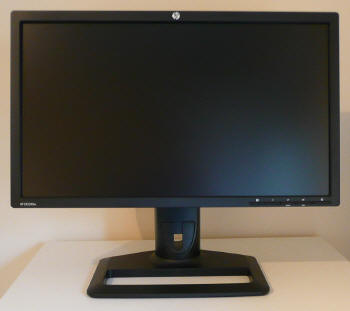
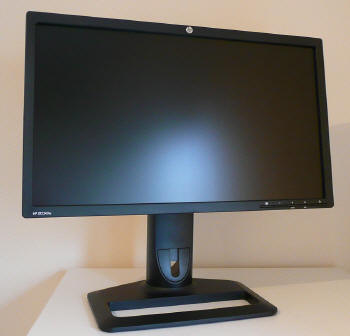
Above: more
front views of the screen, click for larger versions.
The design is the same as the older ZR24W
model. You can see here that the stand has a fairly large footprint which
helps to give it a sturdy base on the desk. The arm which then connects
onto the back of the screen has a small gap at the back which can be used
as a cable tidy.
The panel coating is a standard matte anti-glare (AG) coating. Some users
complain about modern IPS panels having an overly aggressive coating.
Personally I do not find the coating on this screen to be too bad but it can
of course be subjective. The coating
seems to be a little lighter than on some of the other models we've seen such
as the Dell U2410 and the recently tested NEC P241W, with a slightly less grainy feel. It won't feel the same as some of the
glossy or semi-glossy screens of course.
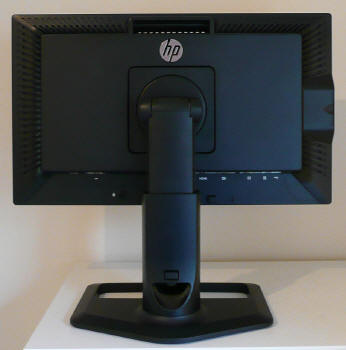
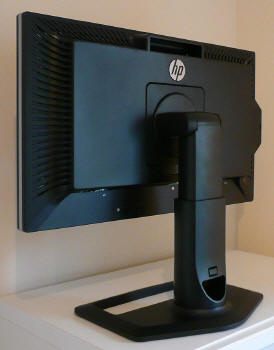
Above: back
views of the screen and stand. Click for larger versions
The back of the screen is squared off and
encased in black plastic as well. There is a larger round HP logo near the
top. You will also notice that there is a carry handle situated at the top
which can be useful when moving the screen around. The monitor arm and
stand click easily into place onto the back of the screen and there is a
plastic release button which makes it easy to disconnect if you need to.
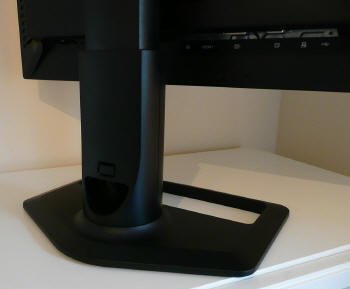
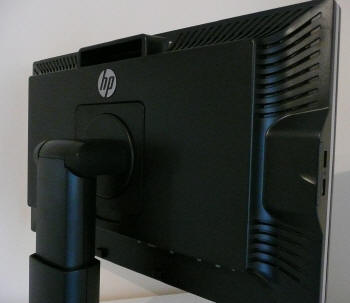
Above: further
rear views of the screen showing the stand, base and carry handle. Click
for larger versions.
Above is a closer look at the base of the
stand and the back of the screen. You will notice that on the left hand
side of the screen there is a section which sticks out a little, where
there are 2 USB 2.0 ports available. We will show a closer view of these
in a moment.
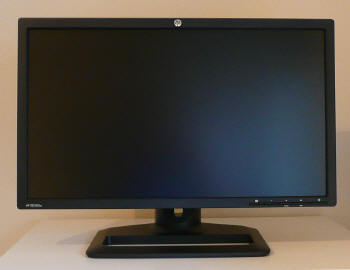
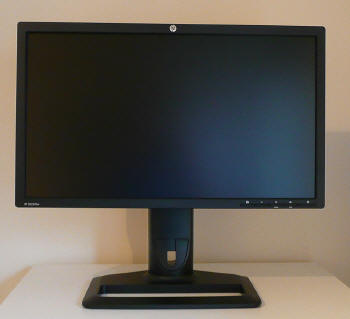
Above: Front
views showing minimum and maximum height adjustment from the stand. Click
for larger versions
There is a reasonable height adjustment
available which allows you to adjust the height within a range of 90mm. At
the lowest setting the bottom of the screen is 62mm from the level of the
desk. In fact at this lowest setting the height adjustment clicks into
place and is locked. This is designed so that you can package and carry it
more easily. There is a small plastic button on the back of the stand you
can press to release the adjustment again. At the highest adjustment the
bottom of the screen is 152mm above the height of the desk. The minimum
and maximum range is shown in the photos above. The movement is smooth and
easy to use.
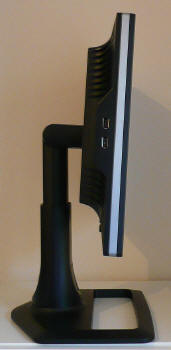
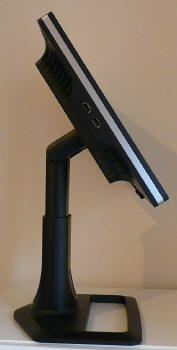
Above: Side
views showing profile and range of tilt adjustment. Click for larger
versions
The tilt range of the screen is very wide as
shown above, allowing you to obtain a comfortable angle depending on your
working conditions. The movement is smooth and pretty easy to use thankfully. You
may notice that the side profile of the screen is quite a bit thinner than
the HZ24W model. This is thanks to the use of W-LED backlighting instead
of a CCFL unit like on the old model.

Above:
Demonstration image of the rotation function of the screen.
The screen offers a rotate function as shown
above in case you want to switch between landscape and portrait modes.
This might be useful on a smaller model like this and I always question
its real value on larger screens. The movement of this is quite 'jumpy'
and stiff to use however. The screens side to side swivel is quite smooth
but again stiff to operate. The base does maintain its position on the
desk when you make the movements though.
It's good to see the full range of adjustments available and the screen
feels very sturdy and well balanced. Some of them are a little stiff to
use but they are still there and the main adjustments of height and tilt
are smooth and simple enough to operate which is good.
A summary of the screens ergonomic adjustments
is shown below:
|
Function |
Range |
Smoothness |
Ease of Use |
|
Tilt |
-5° / +35° |
Smooth |
Moderate |
|
Height |
90mm |
Smooth |
Easy |
|
Swivel |
Yes |
Quite smooth |
Stiff |
|
Rotate |
Full |
Rough |
Stiff |
|
Overall |
Good range of adjustments although some
stiff to use. Sturdy design and feel. |
The screen materials are of a good quality
and the design is attractive in my opinion. There is no audible buzz
from the screen, even if you listen very closely. It also stays nice and cool
during use.
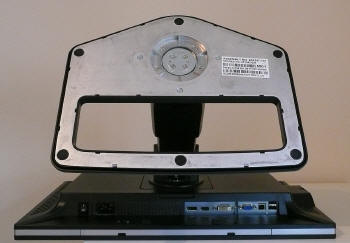
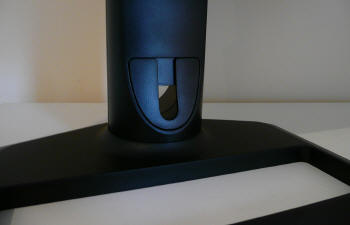
Above: View of
the base of the stand and closer view of base / cable tidy. Click for
larger versions
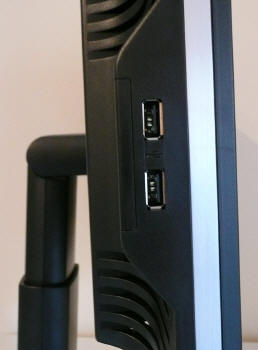

Above: Side USB
ports on the left hand edge and small pull out screen information panel.
Click for larger version (left)
The left hand side features two USB 2.0
ports for quick connection of external devices. Always useful to see I
think. Just behind this there is a small panel which pulls out to tell you
some information about your screen such as product number, serial number,
manufactured date and revision.
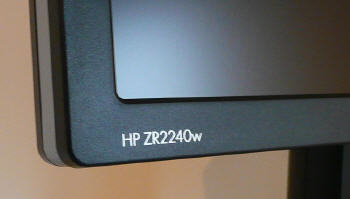

Above: view of
logo and OSD operational buttons. Click for larger versions
The font used for the HP ZR2240w label is
white and so does stand out a little on the all black stand. Being very
picky, it might have been nicer if this was a silver / grey colour so it
was a little more subtle. The labels for the OSD operational buttons are
also in the same colour, and these are situated in the bottom right hand
corner. There is quick access to input selection and auto configuration
(for analogue signals) through these buttons, but you will need to access
the main menu for the rest of the settings and options. There is a very
small LED which glows blue during operation on the far right hand edge of
the screen. In standby this glows amber.
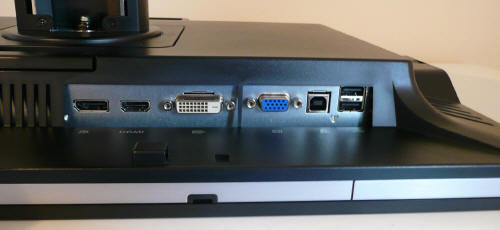
Above: full range of interface connections shown. Click for larger version
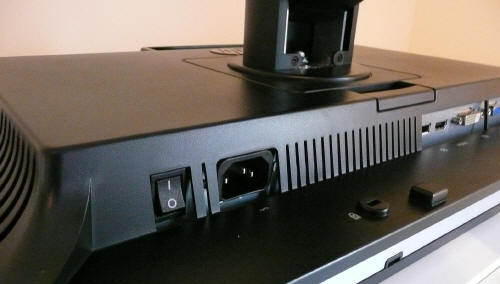
Above: power
connection and switch. Click for larger version
The back of the screen offers a decent array
of video connections. There is (from left to right on the image above)
DisplayPort, HDMI, DVI-D and D-sub available. The digital interfaces are
HDCP certified. To the right of this there is the upstream USB connection
and two downstream USB ports to supplement the ports on the left hand edge
of the screen. A good range of options here I think and nothing really
missing. Good job HP. The left hand side offers the power connection for a
normal kettle lead. There is also an on/off switch as you can see.

OSD Menu

Above: view of
logo and OSD operational buttons. Click for larger versions
The OSD menu is accessed quickly and easily using
the left most control button. This brings you first of all to the main menu as
shown below.
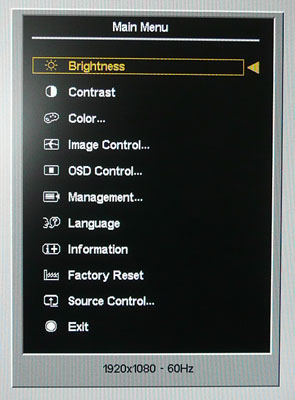
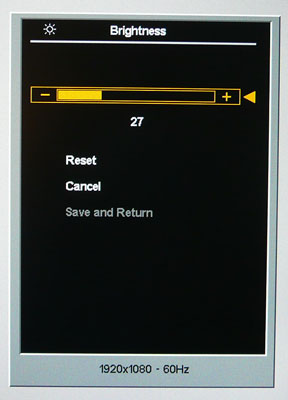
The main menu gives you access to 10 sub-sections. You can move up and down this
list using the + (plus) and - (minus) buttons quite easily. Pressing 'ok' enters
you into any of these sections where you can control the associated options.
Some sections are very brief, like the brightness and contrast sections. Once
inside, you can again highlight the relevant option and press ok to control it.
This works well and is fairly intuitive.
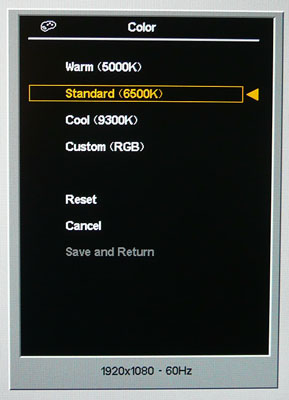
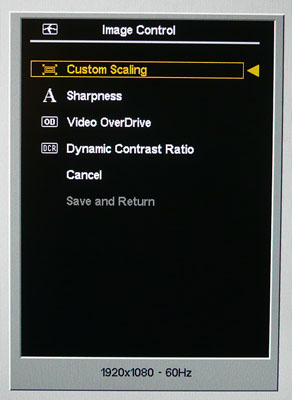
There are more options available in other sections. The 'color' menu gives you
access to the 3 preset colour
temperature modes, as well as the customisable RGB mode. The image section
gives you access to a few interesting features which we will look at throughout
the course of this review. These include
custom scaling,
video overdrive and
dynamic contrast ratio.

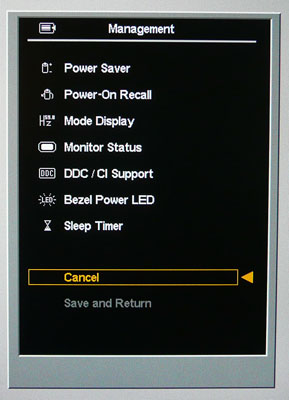
There are options to control the OSD menu itself and several options relating to
power management in the associated sections.
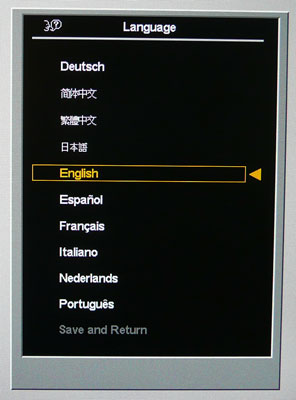
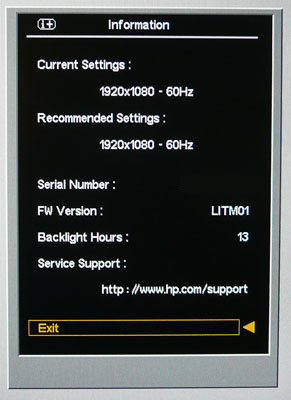
The language section allows you to change the language of the menu and the
information section gives you basic info about the screen and resolution.
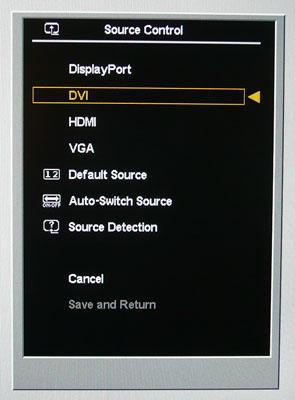
Finally the source control menu allows you to
manually change between the different interface connections. You can also
quickly switch between these using the 'source' button (which is also the +) on
the front of the bezel.
Overall I felt there was a good range of options
available and the menu was easy enough to use. It might have been nice to see
some more preset modes for different uses. The menu also sometimes seems a bit
long-winded to exit if you have drilled into several layers.
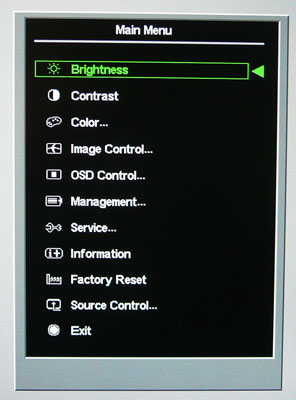
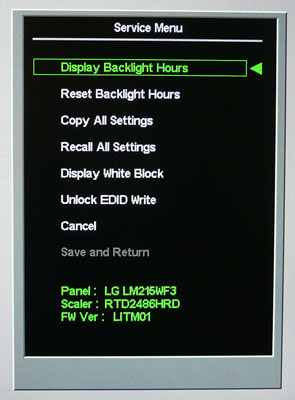
You can access the monitors factory 'service' menu
as well but be careful not to change anything without knowing what you've done
or how to change it back. Use the menu at your own risk! To access the factory
menu, hold the main 'menu' button down while powering the monitor on. Once on,
press 'menu' again and there is an extra section available which has replaced
the 'language' section. The colour of the menu font also turns green to indicate
you are in this mode. Entering the service menu gives you some information about
the screen including confirmation that it is using LG.Display's LM215WF3 e-IPS
panel (the LM215WF3-SLC2 to be precise).

Power Consumption
In terms of power consumption the manufacturers spec states
typical
usage of 35W and 52W maximum. In standby the screen apparently uses <0.3W.
|
 |
|
State and Brightness
Setting |
Power Usage
(W) |
|
Factory Default (90%) |
29.7 |
|
Calibrated (47%) |
22.2 |
|
Maximum Brightness (100%) |
32.2 |
|
Minimum Brightness (0%) |
14.9 |
|
Standby |
0.1 |
|
We tested this ourselves and found that out of the
box the screen used 29.7W of power while at its default 90% brightness setting. After calibration, where we
had adjusted the brightness control to 47% (custom mode) and therefore the backlight intensity, this
was reduced to 22.2W. In standby the screen uses only 0.1W of power. This was
quite comparable of course to the other W-LED models we have tested when
you compare calibrated and standby power consumptions. I have plotted the
results of these measurements on the graph below:


Colour Accuracy, Black
Depth and Contrast
The Panel and Backlighting Unit
The HP ZR2240w utilises an LG.Display
LM215WF3-SLC2 e-IPS panel which is
capable of producing 16.7 million colours. The panel itself actually uses a
6-bit colour depth with Advanced
frame rate control
(A-FRC) to produce the 16.7m colours. This is different to regular 8-bit IPS
matrices, but this is a measure taken to achieve a lower price point for these
modern lower-cost displays.
The ZR2240w uses
White-LED (W-LED) backlighting. The colour space of this screen is
approximately equal to the sRGB reference and is considered a 'standard gamut'
backlight type. The screen covers 72% of the NTSC reference, 75.2% of the Adobe
RGB reference and 97% of the sRGB space. While a 97% coverage of the sRGB space
is decent enough and in line with most W-LED backlit screens, some higher end
uses may require a wider gamut with a full 100% sRGB coverage (and beyond) for
graphics and colour work. A wide gamut screen is another option for those
wanting to work outside of the sRGB colour space.
Testing Methodology
An
important thing to consider for most users is how a screen will perform out of
the box and with some basic manual adjustments. Since most users won't have
access to hardware colorimeter tools, it is important to understand how the
screen is going to perform in terms of colour accuracy for the average user.
I
restored my graphics card to default settings and disabled any previously active
ICC profiles and gamma corrections. The screen was tested at default factory settings using the DVI interface, and analysed using
an
X-rite i1 Pro spectrophotometer combined with
LaCie's Blue Eye Pro software suite. An NEC branded and customised X-rite i1 Display 2 colorimeter was
also used to verify the black point and contrast ratio since the i1 Pro is less
reliable at the darker end.
Targets for these tests are as follows:
-
CIE Diagram - validates the colour space
covered by the monitors backlighting in a 2D view, with the black triangle representing the
displays gamut, and other reference colour spaces shown for comparison
-
Gamma - we aim for 2.2 which is the default
for computer monitors
-
Colour temperature / white point - we aim
for 6500k which is the temperature of daylight
-
Luminance - we aim for 120
cd/m2, which is
the recommended luminance for LCD monitors in normal lighting conditions
-
Black depth - we aim
for as low as possible to maximise shadow detail and to offer us the best
contrast ratio
-
Contrast ratio - we aim
for as high as possible. Any dynamic contrast ratio controls are turned off here
if present
-
dE average / maximum -
as low as possible.
If DeltaE >3, the color displayed is significantly different from the
theoretical one, meaning that the difference will be perceptible to the
viewer.
If DeltaE <2, LaCie considers the calibration a success; there remains a
slight difference, but it is barely undetectable.
If DeltaE < 1, the color fidelity is excellent.

Default settings of the screen were as follows:
|
Monitor OSD Option |
Default Settings |
|
Brightness |
90 |
|
Contrast |
80 |
|
RGB Channels |
n/a |
|
Preset Mode |
Standard (6500k) |

HP ZR2240w - Default Factory Settings



|
|
Default Settings |
|
luminance (cd/m2) |
218 |
|
Black Point (cd/m2) |
0.21 |
|
Contrast Ratio |
1017:1 |
The out of the box performance of the ZR2240w was
reasonable. The
CIE diagram on the left confirms that the monitors colour gamut (black
triangle) very closely matches the sRGB colour space (orange triangle). It
extends a little past the sRGB space in greens in this 2D view of gamut but is a
little short in reds.

Default gamma was recorded at 2.1 average, leaving
it 4% out from the target of 2.2. Gamma was actually closer to the target 2.2 in
the darkest and medium greys where it was recorded at 2.23 and 2.18. This
deviated as low as 2.08 in other lighter shades however. White point was a
little out here at 6014k which was 7% out from the target. Note that we are using a
Spectrophotometer to make these measurements which is not sensitive to the W-LED
backlight as some colorimeter devices can be. When using a standard gamut colorimeter with a
W-LED backlit screen there can be a typical deviance of 300 - 600k in the white
point measurement which is why some sources may refer to a different white point
in this test incorrectly.
Luminance was recorded at a high 218
cd/m2 which is
too high for comfortable use. The OSD is set at 90% brightness and this is far
too much. At this high 218 cd/m2 luminance, the black depth
was still a very good 0.21 cd/m2. This gave us a static contrast ratio of
1017:1 which is excellent for an IPS panel and a pleasing result.
Colour accuracy was fairly good at default factory
settings with an average DeltaE (dE) of 2.2, ranging up to a maximum of 5.9. The
screen felt fairly even at least to the naked eye, although as with most screens
out of the box it was overly bright. Some minor OSD adjustments to the brightness can hopefully help
improve the default set up for casual users who don't have access to a hardware
calibration device. To be fair though this kind of out of the box set up should
be fine for most casual users anyway, and they can just adjust the brightness
control to suit their working environment.

Testing Colour Temperatures

The ZR2240w doesn't offer any defined preset
modes for different uses and instead offers a set of 3 pre-configured colour temperature modes and a
customisable mode with RGB controls. There are options in the 'color' menu for
warm (5000k), standard (6500k) and cool (9300k). The standard mode is the
default and is designed to be close to the 6500k target we aim for in our tests.
We have already established that this is nearer to 6000k and is about 500k out
from the specified colour temperature. As a reminder we are using an i1 Pro
spectrophotometer device here which can accurately read the colour temperature
of the W-LED backlighting.
We measured the colour temperature of the screen
in each of the preset modes to establish how accurate the
settings actually were. All other settings were left at factory defaults and no
ICC profile was active. The results are recorded below:
|
Selected
Preset Mode |
Measured Colour Temperature |
Deviance |
|
Warm (5000k) |
4980k |
-20k |
|
Standard (6500k) |
5993k |
-507k |
|
Cool (9300k) |
7826k |
-1474k |
|
Custom (RGB) |
6068k |
n/a |
As you can see, the warmer the screen setting,
the more close it is to the actual colour temperature the user experiences. At
the warm 5000k setting there was only -20k deviance which was very good. As
we've already established in the previous section, the standard 6500k mode was
about 500k out and a bit too warm compared with the 6500k target. The cool
9300k setting was further out still at 7826k, again being too warm and
-1474k out from the target. The 'custom' setting was measured at its default
settings where RGB levels were all at maximum 255. This gave us a slightly
cooler white point than the 'standard' mode, and was recorded at 6068k.

Calibration Results
I wanted to calibrate and profile the screen to determine what was possible with optimum settings and
profiling. I used the
X-rite i1 Pro spectrophotometer
combined with the LaCie Blue Eye Pro software package to achieve these results
and reports. An NEC branded and customised X-rite i1 Display 2 was used to
validate the black depth and contrast ratios due to lower end limitations of the
i1 Pro device.

HP ZR2240w - Calibrated Settings, Custom Mode
|
Monitor OSD Option |
Adjusted Setting |
|
Brightness |
47 |
|
Contrast |
80 |
|
Preset Mode |
Custom (RGB) |
|
RGB Controls |
235, 218, 255 |

|
|
Calibrated Settings,
Custom Mode |
|
luminance (cd/m2) |
120 |
|
Black Point (cd/m2) |
0.12 |
|
Contrast Ratio |
1005:1 |
I first of all reverted to the 'custom' mode in
the OSD menu which would allow me access to the individual RGB channels. During
the calibration process this would allow me to make more adjustments at the
hardware level which would help preserve grey tones and gradients during the
profiling. This allowed me to obtain an optimum hardware starting point and
setup before software level changes would be made at the graphics card level.
Adjustments were made during the process to the brightness control and to the
RGB channels as shown in the table above. After this I let the software
carry out the LUT adjustments at a graphics card level and create an
ICC profile. The screen does not feature a hardware LUT calibration option
so other than the OSD alterations, the rest of the process is carried out at a
graphics card level in profiling the screen.

The calibration was a success. The gamma
discrepancy that we saw before (4%) had been
almost completely corrected now to leave us with 1% deviance and an average
gamma of 2.2. There was still some slight discrepancy with the gamma curve with
the darkest and lightest greys but it was much smaller than before. White point was also corrected to 6538k, bringing it
1% out from the target. Luminance had been reduced to a more comfortable 120
cd/m2 after the
adjustment of the OSD brightness control to 47%. Black depth was still very good at 0.12 cd/m2 and this gave us an impressive calibrated static contrast
ratio of 1005:1. Colour accuracy was also improved nicely with dE average now
only 0.4
and maximum only 1.1. LaCie would consider colour fidelity to be excellent.
Testing the screen with various colour gradients
showed fairly smooth transitions with some slight gradation in darker tones
being evident. There was also some slight banding in darker tones as well but this
was very minimal and only really visible with gradients and not in normal use.
There was also some very slight temporal noise evident, particularly in darker
tones if you look very closely. This is a result of the FRC algorithm used to
produce the 16.7 million colour palette. It's not something you'd notice in
practice, and you do have to look very closely to see it.
You can use our settings and
try our calibrated ICC profile if you wish, which are available in
our ICC profile database. Keep in mind that results will vary from one
screen to another and from one computer / graphics card to another.

HP ZR2240w - Calibrated Settings, Standard mode
|
Monitor OSD Option |
Adjusted Setting |
|
Brightness |
45 |
|
Contrast |
80 |
|
Preset Mode |
Standard (6500k) |
|
RGB Controls |
n/a |
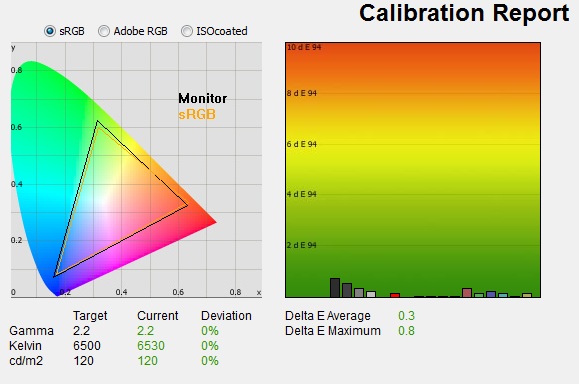
|
|
Calibrated Settings,
Standard Mode |
|
luminance (cd/m2) |
120 |
|
Black Point (cd/m2) |
0.12 |
|
Contrast Ratio |
1002:1 |
I switched to the standard mode again to see what
could be achieved through profiling in this mode. The only hardware changes that
would be made here would be to the brightness control, as the individual RGB
channels would not be adjusted.

Again the calibration was a great success. In fact
it had managed to correct the slight (1%) deviances we'd seen in the custom mode
for gamma and white point which were not pretty much spot on and <0.5% out. The
gamma curve was also more accurate across the range of greys which was good.
Calibrated contrast ratio was an excellent 1002:1 and dE average was 0.3 /
maximum 0.8 which was excellent.
Again, you can use our settings and
try our calibrated ICC profile if you wish, which is available in
our ICC profile database. Keep in mind that results will vary from one
screen to another and from one computer / graphics card to another.

Calibration
Performance Comparisons

I've provided a comparison above of the ZR2240w
against some of the other screens we have tested in a similar size range. Out of
the box average dE was 2.2 which was very good really.
The default colour accuracy of the ZR2240w was comparable to some of the W-LED + 23"
IPS models we have tested including the
Dell U2312HM (2.2),
NEC EA232WMi (2.4) and
Asus ML239H (2.3). It was also quite comparable to the default colour
accuracy of the 24"
HP ZR24W (2.5) which was a standard gamut CCFL unit.
The professional grade 23"
NEC PA231W was better still at 1.6 dE average. A reasonable performance in
terms of default colour accuracy from the ZR2240w and only a little behind
some of the competition really. Some form of software profiling using a colorimeter
would of course be beneficial to correct some of the colours.

Once calibrated the dE average was reduced to 0.4.
This would be classified as excellent colour fidelity by LaCie. It was not quite
as low as some of the other screens here which reached down to 0.2 average, but
in practice you would not notice any difference here. Some of the
professional range models from NEC are even more accurate. Professional grade
monitors like the NEC PA series and P241W also offer other high end features which
separate them from some of these other models, including extended internal
processing, 3D LUT's and hardware calibration. These comparisons are based on a
small selection of tests, so it should be remembered that other factors do come
into play when you start talking about professional use. For further information
and tests of a high end professional grade screen with hardware LUT calibration,
you may want to have a read of our
NEC SpectraView Reference 271 review.


The black depth and contrast ratio of the ZR2240w were
excellent for an IPS panel. Calibrated black depth was 0.12
cd/m2 which
left us with a calibrated static contrast ratio of 1005:1. This was the highest
we had seen in fact from an IPS panel and edged out the Dell U2412M as well
which had taken that crown very recently at 947:1.
The BenQ EW2420 and Samsung F2380 with their AMVA
and cPVA panels respectively offered some fantastic contrast ratios of ~3000:1
which IPS cannot compete with at the moment.
|
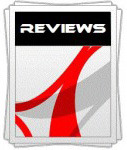 |
This review had been made available to
download and save
in PDF format (.pdf) allowing you to:
-
Save a copy for personal use and
archiving
-
Save and read our reviews offline
-
Read our reviews on your eBook
reader (e.g. Kindle, iPad and other tablets)
Please
visit our Store
for more information and to download a copy. A small fee will contribute
towards the running of TFTCentral and allow us to continue to make high
quality and detailed reviews in the future. |

Contrast
Stability
I wanted to see how much variance there was in the screens contrast as we
adjusted the monitor setting for brightness.
In theory, brightness and contrast are two independent parameters, and good
contrast is a requirement regardless of the brightness adjustment.
Unfortunately, such is not always the case in practice. We recorded the
screens luminance and black depth at various OSD brightness settings, and
calculated the contrast ratio from there. Graphics card settings were left at
default with no ICC profile or calibration active. Tests were made using an
NEC branded and customised
X-rite i1 Display 2 colorimeter. It should be noted that we used the
BasICColor calibration software here to record these, and so luminance at
default settings may vary a little from the LaCie Blue Eye Pro report.
|
OSD Brightness |
Luminance
(cd/m2) |
Black Point (cd/m2) |
Contrast Ratio
( x:1) |
|
100 |
242.9 |
0.23 |
1056 |
|
90 |
213.5 |
0.21 |
1017 |
|
80 |
196.8 |
0.19 |
1036 |
|
70 |
178.5 |
0.17 |
1050 |
|
60 |
160.2 |
0.15 |
1068 |
|
50 |
141.5 |
0.13 |
1089 |
|
40 |
122.7 |
0.12 |
1023 |
|
30 |
103.6 |
0.10 |
1036 |
|
20 |
84.5 |
0.08 |
1056 |
|
10 |
65.3 |
0.06 |
1088 |
|
0 |
46.7 |
0.04 |
1168 |
|
Luminance Adjustment Range = 196.2 cd/m2
Black
Point Adjustment Range = 0.19 cd/m2
Average
Contrast Ratio = 1062:1
|
The luminance range of the screen was very wide
with an overall adjustment range of 196.2
cd/m2. At the
top end, the 100% brightness control returned us a luminance of 242.9 cd/m2
which was only just shy of the maximum specified figure for the screen of 250
cd/m2. The OSD menu brightness control allowed you to adjust this all
the way down to 46.7 cd/m2 which was very good and should allow
almost any user to obtain a comfortable setting, even when working in darkened
environments and low lighting conditions. A setting of around 35 - 40% should
return you a luminance of ~ 120 cd/m2 at default settings. Black
point ranged from 0.23 to 0.04 cd/m2 which was again excellent for an
IPS panel.

We have plotted the
luminance trend on the graph above. The screen behaves as it should, with a
reduction in the backlight intensity controlled by the reduction in the OSD
brightness setting. Between 90
and 100% the brightness range controlled is actually slightly steeper it seems as the
line is not quite linear.
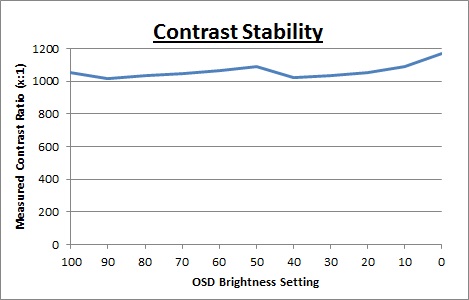
Static contrast ratio
remained high across the range, with an average figure of
1062:1 which was excellent.
It was a little less stable at the lower end of the brightness range below a
setting of ~50%. These contrast measurements were plotted on the graph shown
above.

Dynamic Contrast
|
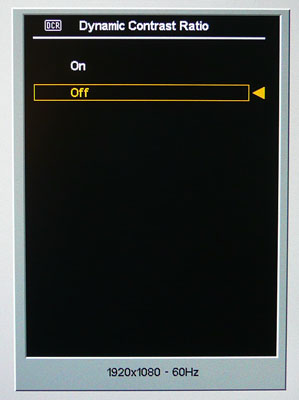
|
The HP ZR2240w features a dynamic contrast ratio
(DCR) control, which boasts a spec of 2,000,000:1 (2 million:1).
Dynamic contrast ratio involves controlling the
backlight of the screen automatically, depending on the content shown on the
screen. In bright images, the backlight is increased, and in darker images, it
is decreased. For this test I would use the colorimeter to record the
luminance and black depths at the two extremes. Max brightness would be
recorded on an all white screen once the DCR has caught up. Black depth would
be recorded on an all black screen.
The DCR feature is available in all of the
preset colour temperature modes and is accessible through the 'image control'
menu. There are options for on and off. The brightness control remains active in the OSD
menu and is not greyed out as it is on some screens. However, if you change
those setting manually it will change the brightness and the
DCR function will be disabled immediately without warning.
|
|
|
Dynamic Contrast |
|
Specified DCR Range |
2 million : 1 |
|
Available in Presets |
All modes |
|
Settings |
On / Off |
|
Max luminance (cd/m2) |
218.71 |
|
Min Black Point (cd/m2) |
0.09 |
|
Max Dynamic Contrast Ratio |
2430:1 |
The tests that we carry out to measure dynamic
contrast ratio involve an almost completely white and almost
completely black screen. In real use you are very unlikely to ever see a full
black or full white screen, and even our tests are an extreme case to be honest.
Carrying out the tests in this way does give you a good indication of the
screens dynamic contrast ratio in real life situations however.
Unlike a lot of screens we have tested recently,
this DCR did seem to function a bit which was good. You can see the transitions
with the naked eye easily as you switch between dark and light content. The
changes are very fast however so there is no gradual change or subtle
transition. This function seemed to control the luminance up to a maximum of
about 218.7 cd/m2
and a minimum black point of 0.09 cd/m2. This gave us a useable
dynamic contrast ratio of 2430:1 which was ok, but a long way off the specified
2 million:1 of course. We tested the screen with a completely all black screen
but that didn't seem to turn the brightness level down any further as it does
with some screens - where it actually turns the backlight off!
Even if we took the maximum
luminance we measured in the previous section of 242.9
cd/m2,
and the lowest black point of 0.04 cd/m2, this would still only give
us a maximum theoretical DCR of 6073:1. The screen would never live up to its 2
million:1 spec though as you would have to be turning the backlight off to reach
a lower black point than 0.04 cd/m2. In
fact it would be then tending towards infinity:1 if you consider its black point
is basically then 0
cd/m2 but this
doesn't happen anyway. At least the feature works a bit for those who like DCR.

Viewing Angles

Above: Viewing
angles shown from front and side, and from above and below. Click for
larger image
Viewing angles of the HP ZR2240w are very good,
as you would expect from a screen based on an e-IPS panel. Horizontally there
are very wide fields of view with a small contrast shift only really becoming
noticeable from a fairly wide angle of about 45°. At more extreme angles the
image goes a little darker and a slight pinkish tint is introduced. Vertically, the contrast shift
was a little more pronounced but the fields of view were still good.
The
panel is free from any off-centre contrast shift which you see from VA matrices,
and this is why IPS technology is so highly regarded in the colour enthusiast
and professional space. It is also free of the very noticeable contrast and
colour tone shifts you see from TN Film panels vertically.
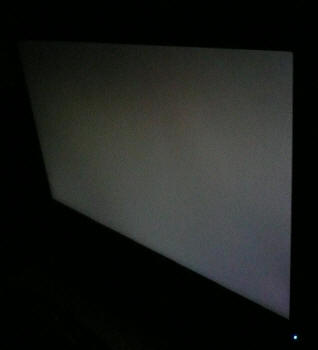
Above: View of an
all black screen from the side. Click for larger version
On a black image there is a characteristics IPS
white glow, but in normal working conditions this shouldn't present much
problem. The above image was taken in a darkened room to demonstrate the white
wide angle glow when viewing a black screen. There is no A-TW polarizer on this panel which is rarely used
now in the market but was implemented on some older screens to improve the off
centre black viewing. If you are viewing dark content from a close position to
the screen you can sometimes see this pale glow on parts of the screen towards
the sides and corners because of your proximity to the screen and your line of sight. The
edges of the screen are at an angle from your line of sight which means you pick
up this white glow to a smaller degree. This disappears as you move backwards
away from the screen where the line of sight does not result in a wide angle
view of parts of the screen and you can see the screen largely from head on.
That is a little difficult to explain but hopefully makes sense. It is only
really apparent on darker content.

Panel Uniformity
Measurements of the screens luminance were taken
at 35 points across the panel on a pure white background. The measurements were
taken using BasICColor's calibration software package, combined with the NEC
customised X-rite
i1 Display 2 colorimeter. The above uniformity diagram shows the difference, as
a percentage, between the luminance recorded at each point on the screen, as
compared with the reference point of a calibrated 120 cd/m2. This is
the desired level of luminance for an LCD screen in normal lighting conditions,
and the below shows the variance in the luminance across the screen
compared with this point. It is worth noting that panel uniformity can vary from
one screen to another, and can depend on manufacturing lines, screen transport
and other local factors. This is only a guide of the uniformity of the sample
screen we have for review.
Uniformity of Luminance

The luminance uniformity of the ZR2240w was
mostly good. Around 90% of the screen showed very little deviation from the
central point and was within 10% variation of the 120
cd/m2. There was a section in the top
right hand corner where luminance uniformity was not as good, and luminance
dropped down to around 97 cd/m2 (-24% deviance) which was a
shame. Still overall a pretty good performance in this test.
Backlight Leakage
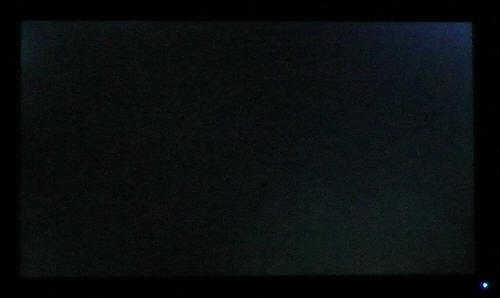
Above: All black screen in a darkened room. Click for larger version
As usual we also tested the screen with an all
black image and in a darkened room. A camera was used to capture the result.
There was very little leakage from the backlight unit here which was pleasing.
There was some slight variance from the four corners, with the most noticeable
leakage coming from the top right hand corner. This was not too severe at all
and not something you'd notice in practice. A good result again from this
relatively low cost display.

General and Office Applications
The ZR2240w has a nice high resolution of 1920 x
1080 which is good for side by side office work and a high resolution
considering its relatively small 21.5" screen size. I don't think it's as practical
as a 16:10 format screen with 1920 x 1200 resolution though as you do lose a bit
vertically. The screen of course felt a bit smaller than a 23"/24" model with
the same resolution, which you do notice when moving from one to the other. The aspect
ratio of this screen is a pretty common trend in today's market with the move to
multimedia orientated displays and widescreen formats.
With a pixel pitch of
0.248mm, the text was comfortable and of a decent size for prolonged office use.
It was a little smaller than 23" 1920 x 1080 screens but still perfectly
readable. If anything I personally preferred the slightly tighter pixel pitch
and small font size on this model. It was not as small as the 0.233mm you get on
a 27" screen with 2560 x 1440 which I think might be a little too small for some
users. A good middle ground here from this screen I think. Picture quality was very good using the DVI and D-sub connections, with DVI
providing a slightly sharper image.
You will want to turn down the default brightness
setting for the screen as the luminance is too high out of the box. A reduction
from 90% to around 35 - 40% should return a more comfortable luminance around the
120 cd/m2
mark out of the box. The screen is capable of offering low luminance settings
through the backlight control as well which is good for those wanting to work in
darker lighting conditions. Unlike some screens this is all controlled by the
backlight and so you do not sacrifice contrast ratio, even at the lowest
settings.
There are no preset
modes available for 'text' or 'internet' here so you would have to make do with
one of the other colour temperature modes set up to your preference.
Some models are starting
to use ambient light sensors and dynamic brightness control which I think can be
useful for office use. There isn't one featured on this model however.
Ergonomically the screen was very good, with a
decent range of tilt and height adjustments available. There's a
rotate function as well in case you want to work in portrait mode. Some of these
movements were stiff to operate though which is a shame, but the stand and
design is very sturdy. The easy
access 2x USB 2.0 ports on the left hand side are useful for connecting
printers, cameras etc, but it might have been nice to have a card reader as well
like on some other models like some of the Dell range for instance.

Above: photo of
text at 1920 x 1080 (top) and 1680 x 1050 (bottom)
The screen is designed to run at its native
resolution of 1920 x 1080 and at a 60Hz recommended refresh rate. However, if
you want you are able to run the screen outside of this resolution. We tested
the screen at a lower 1680 x 1050 resolution to see how the screen handles the
interpolation of the resolution. At native resolution the text was very sharp
as you can see from the top photograph. When you switch to a lower resolution
the text is a little more blurry, but actually still very good. There was
minimal overlap of the pixels and text was still very readable. It was certainly
better than some other screens we have tested. Native resolution is still
recommended where possible though.

Responsiveness and Gaming
Response Time Control
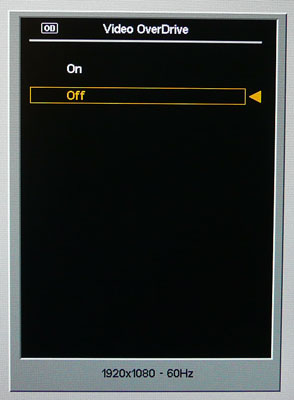
Before we get in to the get into the side by side
screen comparisons I want to quickly talk about the
overdrive control available through the screens OSD menu. It is available
within the 'image control' section under the 'Video OverDrive' option as shown
above. This allows you to manually control the overdrive / RTC impulse being
applied to the pixels, with a setting of on and off available. Overdrive is
designed to help improve pixel responsiveness and reduce motion blur and
ghosting in practice by speeding up the transitions the pixels make to change
from one colour to another. You may wish to read our
specs section for some further information about overdrive / response time
compensation.
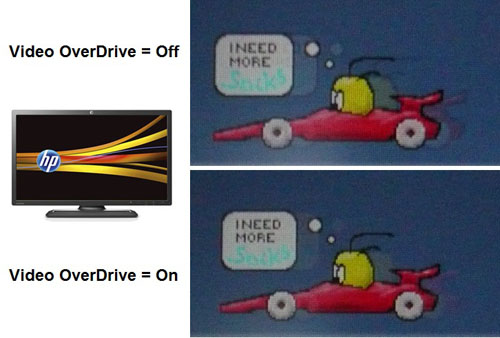
The screen was tested using the chase test in
PixPerAn, a good bit of software for trying to quantify differences in real
terms responsiveness between monitors. As a reminder, a series of pictures are
taken on the highest shutter speed and compared. The images above are the best
case examples from the screen with the 'Video OverDrive' function off and then
on. To be honest the results of both seemed to be very good. With the setting
off there was a slightly more pronounced motion blur behind the moving car, but
it was not too bad at all. When you enabled the feature you can spot that the
blur is reduced and the moving image becomes sharper. Thankfully there is no
obvious 'overshoot' introduced which can be caused where these overdrive
impulses are too aggressive or poorly controlled. They can result in dark or
pale artefacts and halos behind the moving object in severe cases, but there was
no sign of anything like that here. The overdrive impulse seemed to work very
well and didn't come with any nasty side-effects. For optimum performance in
games and with fast moving images I would recommend 'Video OverDrive' is turned
on.
Display Comparisons
The screen was tested again using the chase test
in PixPerAn for the display comparisons. As a reminder, a series of pictures
are taken on the highest shutter speed and compared, with the best case example
shown on the left, and worst case example on the right. This should
only be used as a rough guide to comparative responsiveness but is handy for a
direct comparison of the impact of this setting:

21.5" 8ms G2G
LG.Display e-IPS (W-LED) - Video OverDrive = On

23" 8ms G2G
LG.Display e-IPS (W-LED)

23"
5ms G2G LG.Display e-IPS (W-LED) - Trace Free setting 40

23"
5ms G2G LG.Display e-IPS (W-LED)

23"
14ms LG.Display e-IPS (W-LED)
The ZR2240w is rated by HP as having an 8ms G2G response time which implies the use of
overdrive /
response time compensation (RTC) technology, used to boost pixel
transitions across grey to grey changes. We know this to be true as we have
already looked at the OverDrive function available in the OSD menu. The panel
being used is an LG.Display LM215WF3-SLC2. Have a read about response time in
our
specs section if any of this is new to you.
I have provided a comparison of the ZR2240w first
of all above
against 4 other screens we have tested which use IPS panel technology and W-LED
backlighting, all in the 23" sector. The ZR2240w shows less motion blur in moving images than the LG
IPS231P despite that screens rather bold spec of 5ms G2G. In fact we had already
concluded from
our review that the IPS231P performed much like the NEC EA232WMi which has a
14ms response time and does not use RTC technology. This goes to show that you
can't always trust a reported spec. The ZR2240w shows a similar low level of
motion blur to the 5ms G2G rated Asus ML239H which was positive certainly. The
Dell U2312HM showed a similar low level of motion blur in these tests but did
introduce a negative dark overshoot due to the poorly controlled RTC impulse.
Thankfully there are no obvious overshoot issues on the HP model.

21.5" 8ms G2G
LG.Display e-IPS (W-LED) - Video OverDrive = On

21.5" 8ms
G2G LG.Display e-IPS (Overdrive ON)

21.5"
8ms G2G LG.Display e-IPS
I have provided a comparison of the ZR2240w against
some other models in the 21.5" monitor range that we have tested. The ZR2240w
performs very comparably to both of these other models in practice and all are
rated with an 8ms G2G e-IPS panel. Very little to separate these three models,
which is good since the two Dell offerings are well regarded in this area.

21.5" 8ms G2G
LG.Display e-IPS (W-LED) - Video OverDrive = On

24" 5ms G2G LG.Display e-IPS (Overdrive Off - see review for why)

24" 6ms G2G LG.Display H-IPS
Above is a comparison of the ZR2240w against two other HP models we have tested,
both 24" IPS models.
The ZR2240w shows a very similar level of performance to the ZR24W in these
tests. There is some slight improvement compared with the older LP2475W since
although the motion blur is reduced a little on that model, there is the introduction
of a slight dark overshoot artefact unfortunately.

21.5" 8ms G2G
LG.Display e-IPS (W-LED) - Video OverDrive = On

24" 8ms G2G
LG.Display e-IPS (W-LED)

24"
8ms G2G AU Optronics AMVA (W-LED)

23"
8ms G2G Samsung cPVA (Response Time setting = Fastest)
I have also provided a comparison of the ZR2240w against other competing 23"
- 24" IPS models here. The ZR2240w offers probably the best performance out
of these models. The Dell U2412M has a very low level of motion blur as well,
but does have a noticeable dark overshoot which is a shame. Not too severe, but
something the HP is thankfully free from. There is certainly a marked
improvement over the fairly slow Samsung F2380 (cPVA panel), and frankly quite
disappointing BenQ EW2420 (AMVA panel).

21.5" 8ms G2G
LG.Display e-IPS (W-LED)

23.6" 2ms G2G CMO TN Film (120Hz)

22" 3ms G2G Samsung TN Film + 120Hz
I've also included a comparison above against two
gamer-orientated screens, both featuring heavily overdriven TN Film panels, and
120Hz technology. The pixel responsiveness of both of these is ahead
of the ZR2240w, and the 120Hz frequency allows for
improved 120fps frame rates and the support of 3D content as well. The BenQ
XL2410T does show some even more obvious RTC overshoot in the form of very dark
trails behind the moving image (speech bubble and head) which is unfortunate,
and a sign that the RTC impulse is too aggressive. The Samsung 2233RZ remains
our champion in this test.
The responsiveness of the ZR2240w should be perfectly fine for gaming, even at
quite high levels. For an IPS panel it is a very good performer and on par with
some of the faster models we have tested which was pleasing. The overdrive
control should be enabled for optimum performance and it was good to see that
this hadn't introduced any adverse affects.
Additional Gaming Features
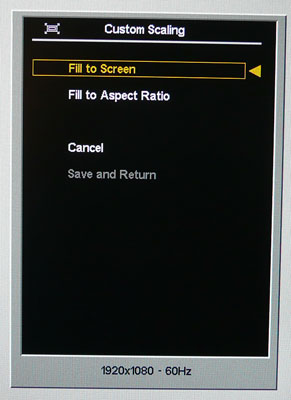
Aspect Ratio Control - The ZR2240w supports
limited
aspect ratio control options through the OSD 'image control' menu as shown above. There are options
for 'fill to screen' and 'fill to aspect ratio' here at least. However, a defined 1:1
pixel mapping mode is lacking here.
Preset Modes - There are no specific preset
modes available for gaming, so you will either have to use your standard mode,
or perhaps use one of the other colour temperature modes. The dynamic contrast ratio is
available in all of these modes and works to a small degree at least.

Input Lag
We've had some reader enquiries recently about
input lag and so thought we would give a bit more information here before we
discuss the results obtained for this display:
What is Input Lag?
Input lag is described as the lag between the output from a graphics card and
the image which is displayed on the screen you are using. This should not be
confused with pixel response time which describes the speed at which a pixel can
change from one orientation to another. Pixel response times impact aspects such
as motion blur and ghosting, whereas input lag is a delay between what is sent
to the monitor, and what you actually see. Of course both do contribute to the
overall performance and experience of the display when used for gaming.
Input Lag Measurement Techniques - The Stopwatch Program
Traditionally input lag has been widely measured by hooking up a CRT screen to
the same graphics card and PC as the TFT display. By cloning the output, the
user could provide a comparative test of the output of the CRT vs. the output of
a TFT. A CRT would show no lag on top of the output from the graphics card which
is vital for those wanting to play fast games, where reaction times are key.
This is what many users are used to, having come from older CRT displays. Many
high end gamers still use CRT's as well for high refresh rates and frame rates
and so the move to a TFT can be worrying, especially when you start throwing in
a conversation about lag of the output image.
By running the screens side by side in this way in clone mode, you can often see
that the TFT lags behind the CRT. This is sometimes noticeable in practice even,
but stopwatch programs have been used for many years to give a way to record and
synchronise the output so that the difference could be recorded. High shutter
speed photographs can then be taken to show just how much the TFT lags compared
with the CRT. The level of lag really depends on the TFT display, and is
controlled by many signal processing factors including, but not limited to the
internal electronics and scaling chips. Some manufacturers even take measures to
help reduce this, providing modes which bypass scaler chips and options which
reduce the input lag. These are often reserved for gamer-orientated screens but
the results are often quite noticeable.
This stopwatch method has been used for many years by many review websites and
end users. It's easy to set up, doesn't cost anything and allows a reasonable
comparative view of a CRT output vs. a TFT output. It can also be useful for
providing a comparison between different models over time.
The method is admittedly not 100% accurate however. There are areas of
inaccuracy inherent to this method. Some stopwatch programs are based on flash
which can introduce issues with frame rate support, especially when viewed from
an internet source and browser. The programs can introduce a degree of error if
vsync is active and due to 2D native refresh rate settings of 60Hz. There's
never been a defined standard for measuring input lag and so this has been used
for a long time and widely accepted as a decent enough representation of what a
user may experience.
More Advanced Measurement
Techniques
Some websites take this whole area one step further and even use an oscilloscope
and photosensor to measure the input lag of a display. This is of course an even
more precise measurement and can help you show the true image lag along with the
typical response times of a pixel transition. This is then used to give you both
the overall experienced 'lag' of the image and the lag specifically between the
electronics and the pixel change instruction (the pure signal processing time).
We do
not have access to such a method at this time and of course it would not come
cheap.
We are investigating alternative means to measure input lag in the future for
our reviews in an effort to help provide even more accurate results. We did not
want to completely remove this section since I know it is useful to many readers
and it would be missed. While it might have varying degrees of accuracy, I will
say that this method has been used for many years by many sources and although
there is likely a varying degree of error introduced in this method, it can
still allow you to give a reasonable comparison between displays.
Classification of the lag into low, medium and high for instance is possible and
the method can help give you an idea of the relative output of a TFT compared
with a CRT. It's an indication though as opposed to a precise measurement.
If you are particularly bothered about input lag then I would encourage you to
compare results between sources and refer to other review sites as well where
methods like this are used. In many cases the figures are actually quite
comparable but by all means if you need absolute measurements refer to other
sources as well to help with your decision.
Input Lag
Classification
To help in this section we will also introduce a broader classification system
for these results to help account for some of the remaining error in the method
and classify each screen as one of the following levels:
-
Class 1)
Less than 16ms / 1 frame lag - should be fine for gamers, even at high levels
-
Class
2)
A lag of 16 -
32ms / One to two frames - moderate lag but should be fine for many gamers.
Caution advised for serious gaming and FPS
-
Class
3)
A lag of more
than 32ms / more than 2 frames - Some noticeable lag in daily usage, not
suitable for high end gaming
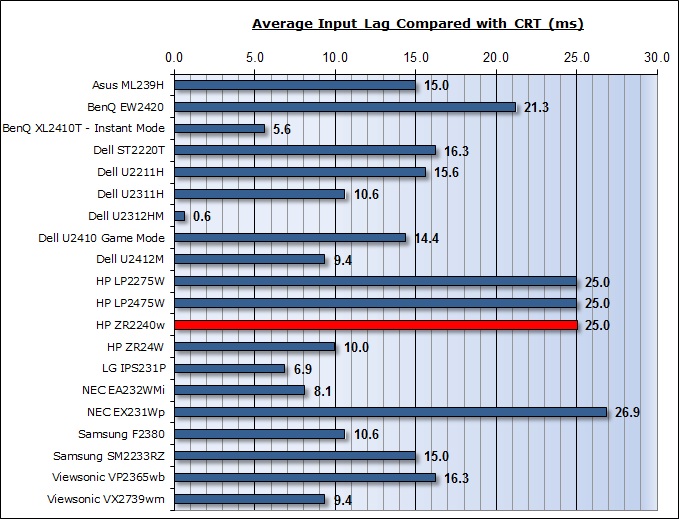
|
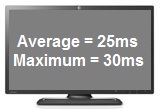 |
 |
Class
2 |
On to our tests then in their current form. The HP
ZR2240w showed an average input lag of 25ms during this test, ranging up to 30ms
maximum. This was on par with the older HP models we have tested (LP2475W and
LP2275W) which both showed an average lag of 25ms. The HP ZR24W was a little
faster at 10ms. Some other screens of a similar size like the Dell U2212H
(15.6ms) and Dell ST2220T (16.3ms) showed a slightly lower level of lag. The lag
of this screen has been categorised as CLASS 2 as detailed above. This should be
fine for most moderate gaming still but for those wanting to play fast FPS it
might prove an issue in some cases.

Movies and Video

The following summarises the screens performance
in video applications:
-
21.5" screen size makes it a reasonably small option for
an all-in-one multimedia screen, a quite a bit smaller than modern LCD
TV's of course. A larger screen of 23" or above would be more suitable for movie
viewing.
-
16:9
aspect ratio is more suited to videos than a 16:10 format screen, as it leaves
smaller borders on DVD's and wide screen content.
-
1920 x
1080 resolution can support true 1080 HD resolution content
-
Digital interfaces DVI, HDMI and DisplayPort supports HDCP for any encrypted and protected content
-
Additional DisplayPort and HDMI interfaces are present and good to see as they
are
popular and very useful for external Blu-ray / DVD player connectivity.
-
Black depth and contrast ratio are excellent for an IPS panel. Detail
in darker scenes and shadow detail should not be lost due to these measurements.
-
Dynamic contrast ratio is available but has very fast transitions and only
works to a small degree. It should allow a DCR up to about 2430:1 however for
those who like this technology.
-
No
'Movie' preset mode available at all so you would need to use one of the other
defined colour temperature modes or your user calibrated custom mode.
-
Very
good pixel responsiveness which should be able to handle fast moving scenes in
movies without issue.
-
Wide
viewing angles thanks to e-IPS panel technology meaning several people could
view the screen at once comfortable and from a whole host of different angles.
-
Very
good ergonomic adjustments available from the stand allowing you to obtain a
comfortable position for movie viewing. Some movements are stiff so regular
adjustment might be a pain.
-
No
significant backlight leakage from the panel which was pleasing. Thankfully no leakage along any of
the edges which has the potential to become distracting when
watching movies, especially where black borders are present.
-
No
integrated stereo speakers on this model
-
No
picture in picture (PiP) or picture by picture (PbP) modes available on this
model.

Conclusion
|
 |
This review had been made available to
download and save
in PDF format (.pdf) allowing you to:
-
Save a copy for personal use and
archiving
-
Save and read our reviews offline
-
Read our reviews on your eBook
reader (e.g. Kindle, iPad and other tablets)
Please
visit our Store
for more information and to download a copy. A small fee will contribute
towards the running of TFTCentral and allow us to continue to make high
quality and detailed reviews in the future. |
The ZR2240W offered a very decent all round
performance I felt for what is nowadays a relatively small screen size.
Manufacturers might be forgiven for leaving the 20 - 22" sector fairly light of
modern innovation, leaving it to be over-run by low cost TN Film panels for
general home and light office use. HP have instead introduced something here
which offers the feature set and performance of a much larger and higher end
screen. There is a great range of interface connections including DisplayPort
and HDMI together which should satisfy most users with external devices to
connect. Ergonomically the stand offered a full range of adjustments, although
some were a little difficult to use admittedly. The OSD menu also provides a
good range of adjustments and extras to play with.
Performance wise the ZR2240w offered a very good
all round performance that one might hope for from an IPS panel. Decent enough
out-of-the-box setup and the usual very good performance once calibrated was
combined with the best calibrated contrast ratio we have seen so far from an IPS
panel. Pixel responsiveness was very good and the screen should easily be able
to handle some fairly high levels of gaming if you need. Even areas like
uniformity and backlight bleed were actually pretty good which was pleasing
considering it's a relatively low cost display. Gosh, even dynamic contrast
ratio worked to a degree which is something we don't find ourselves saying very
often!
The ZR2240w
retails for £240 GBP (inc VAT) on HP's website and can be found for between
approximately £215 and £250 online through some retailers. This leaves it a
little more expensive than some competing IPS based models like the Dell U2212HM
(review coming very soon!) which is around £195 and the older U2211H model which
is ~£180. These are all more expensive than the wide range of TN Film models as
you might expect but they do offer a far better all round performance and a wide
range of options and features. If you want something more than the run of the
mill basic display in a smaller size like this, the ZR2240w is worth a
consideration for sure.
|
Pros |
Cons |
|
Excellent black depth and
contrast ratio for an IPS panel |
Ergonomics and screen
movements were quite stiff and could be better |
|
Very good range of interface
options and ergonomic adjustments |
Some slight backlight bleed
and uniformity issues, mostly from one corner (may vary) |
|
Very good pixel responsiveness
for gaming |
Missing some features like
preset modes and other aspect ratio control options |
|
If you have enjoyed
this review and found it useful, please consider making a
small
donation to the site. |